Tuesday, July 31, 2012
Week 6 - no pics
Just a quick update - I did in fact shoot several rolls of film this week, but they were all production stills for a movie I was producing. I will post shots as soon as I've gotten approval from the director to publicize things, hopefully by next week.
Monday, July 23, 2012
Week 5 - Hasselblad
The Blad is Back
When I finished graduate school and got my Master's degree, I decided to buy myself a graduation present. I have, for as long as I've been interested in photography, wanted a Hasselblad V series camera. You may remember it as the camera on the cover of that Elvis Costello album.So I went ahead and bought one from a gentleman on craigslist. And a week later its shutter broke.
To be fair, I don't think he knew he was selling me a not-quite-broken camera, he just hadn't had it serviced in a while and probably didn't use it much. Caveat emptor and all that. But it was still a big blow; I was given a taste of the dream and then had it yanked away from me.
So I sent it off to Massachusetts, to the best Hasselblad technician the Internet could recommend. One month and several hundred dollars later, it came back in like-new rebuilt condition. I was ready to lock and load.
I shot two rolls on Sunday the 22nd. Here are the highlights.
Roll 1 - Rachel in the Window
 | ||
| Portrait of Maud Cook Thomas Eakins, 1895 - image from Wikipedia |
- Don't get too fancy with your composition. If you throw in a lot of context, you'll probably end up cropping it out later. Focus on faces.
- Cool it on including the light source in the photo.
I took as my inspiration another Eakins painting, Portrait of Maud Cook. It is another fantastic portrait that uses a directed light source to display the subject in a pleasing, if not necessarily flattering, light. Eakins was known for the strong realism in his portraiture, he didn't try to make people look younger or prettier than they were. But for all that, their direct presentation still leaves people looking attractive. I think that's what draws me to them.
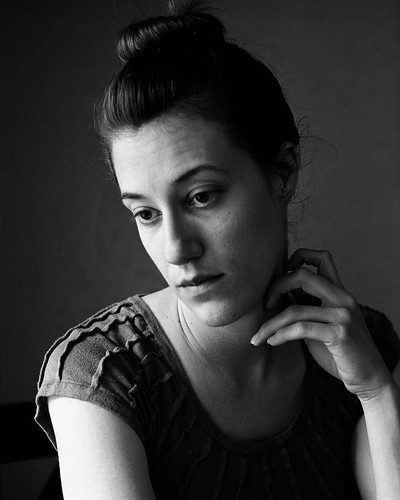 I sat Rachel by a window and set about shamelessly
I sat Rachel by a window and set about shamelessly Thus, these shots are cropped to an 8x10 aspect ratio. I am less upset this week about that, though, because I shot these intending to crop them. All that's missing is about another two inches of that grey wall to Rachel's right.
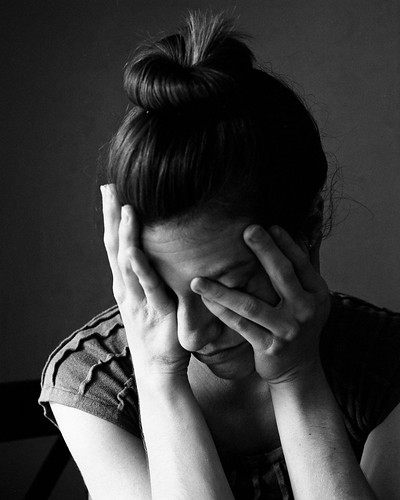
I'm very happy with the way my new lens handled the contrast on this; coupled with the relatively grainy Tri-X film I shot them on, I think they almost have an abstract quality that is similar to the painting that inspired them.
I really like the photo of Rachel holding her head in her hands, and I'd like to claim that I directed her to do that, but that's a genuine moment. She was feeling a little tired and a little frustrated with me for making her sit by the window for so long while I fiddled with my new camera.
Thus, another lesson. I need to work on not only my technical skills, but my interpersonal skills as well. Rachel lets me take her picture all the time, she's used to me--but some people are going to be nervous about having their picture taken.
My "bedside manner" if you can call it that could stand to be improved. I am usually too focused on the technical aspect of the image and not on whether or not my subject is at ease. I think it comes partially from my personality, which is not terrifically gregarious, but also from my background in filmmaking. Perhaps if I were a documentary filmmaker I'd have learned something about putting my subjects at ease, but as a narrative filmmaker the people with a camera pointed at them all want to be there and more often than not have done it before.
Roll 2 - Campus
After shooting with Rachel, I went to the University of Texas campus to play with my new lens outside. Not shooting people allowed me to both use the native square format of the film and also focus more on textures. |
| Main Building |
 |
| Calhoun Hall breezeway, South Mall |
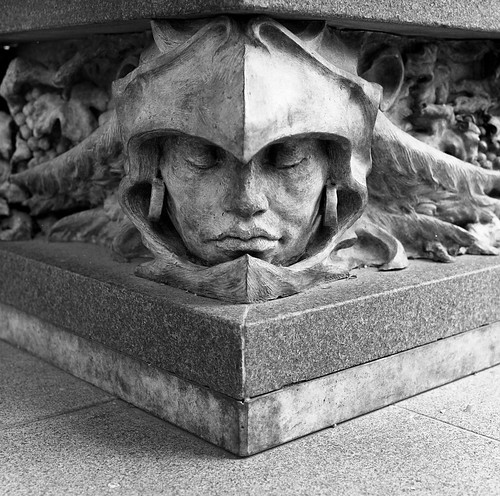 | |
| Cesar Chavez statue, West Mall |
I look forward to getting more comfortable with my new camera. Thanks for reading, I'll keep trying to post something new every week.
Monday, July 16, 2012
Week 4 - Emulating Eakins, Foiled by a Lamp
Lessons from Portraiture
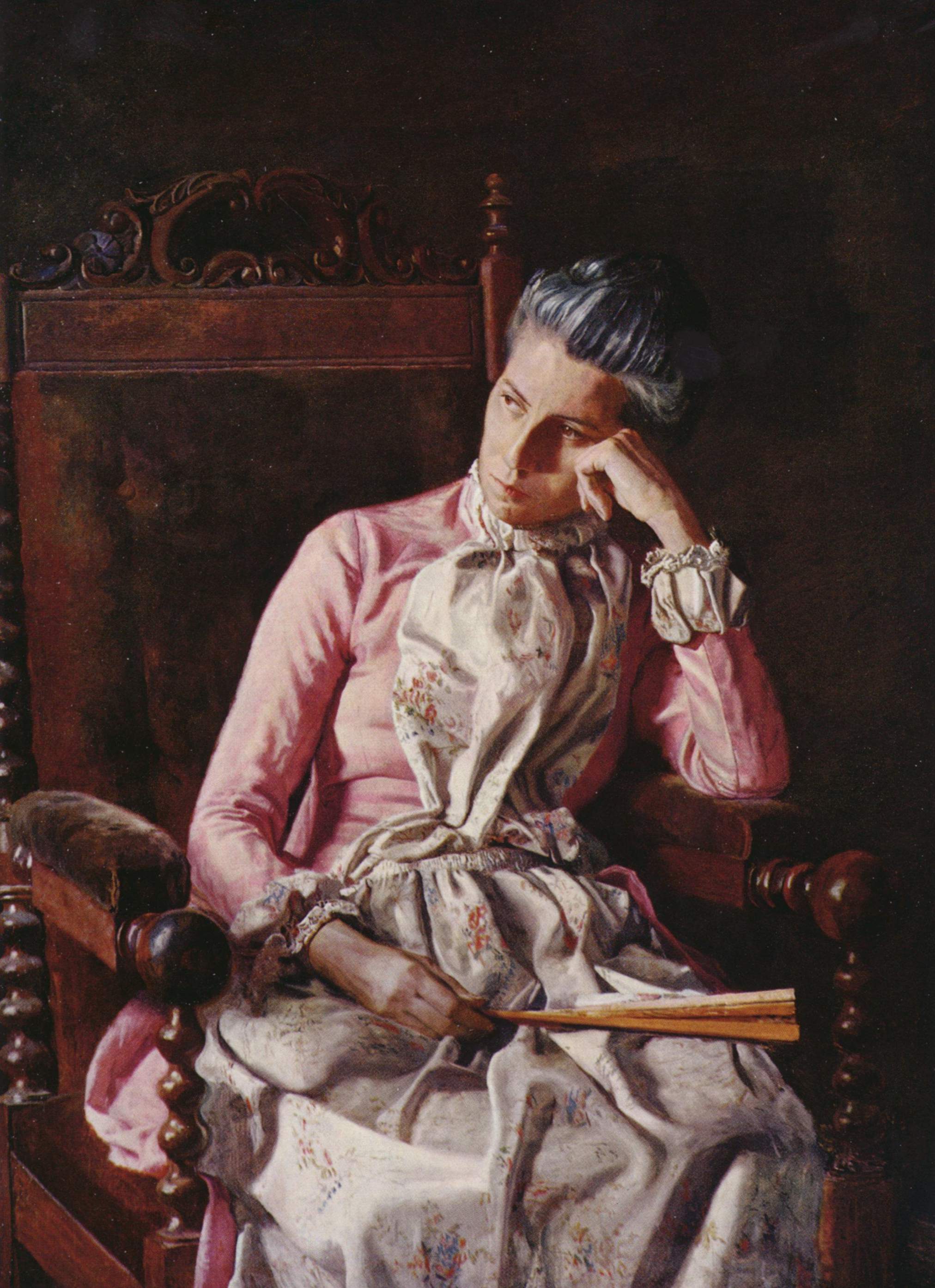 | |
| Miss Amelia Van Buren Thomas Eakins, 1891 - image from Wikipedia |
I came upon Eakins when I was looking for inspiration for portraiture. When you are a writer, especially before you have discovered your own style, you are supposed to find a writer you like and shamelessly copy him/her until your own voice emerges. I thought that I would do well to think along the same lines.
I find myself interested in very expressive, moody use of light. In film school, I had a cinematography teacher tell me that studying paintings was a great way to get a feel for artistic use of light; now, here I am, ten years later, listening to her.
Anyway, I decided that I would sit down with Rachel and try to get a very deliberate portrait, inspired by Eakins (and especially the painting of Miss Van Buren). I'm sure it would take a lifetime of study to fully appreciate everything a master painter does, but I observed a few things from his style that I could immediately emulate.
First, subjects almost never look toward the viewer. This gives the portrait more of a "narrative" feel--what are they looking at? What are they thinking about? If they look at you, they are engaging directly with you, but if they're focused on something else, they're enigmatic.
Second, light is strongly motivated from one side, and shadows are important.
I generally try to do these things already, but not in as deliberate or careful of a way. So I got my medium-format camera, moved a bunch of stuff in the living room around, and put Rachel on the couch.
That Damn Lamp
 |
| HAI I'M A LAMP LOL |
While shooting, I thought I had everything lined up beautifully. However, after developing and seeing the photos on the proof sheet, I immediately realized two errors.
The first is relatively minor. There's an ugly seam on our wall behind the couch that I thought would be in shadow. I should have read the light back there; if I'd known you could see it I'd have reframed the shot.
The second problem, though, is kind of a big deal to me. It has to do with that lamp.
I thought the lamp would look cool; it would be obvious where the light was coming from and it would contrast with the relatively darker area of the subject. Having seen the photo, though, I completely disagree. It takes up almost a quarter of the frame!
Here I have this somewhat interesting scene, and there's a giant glowing eye magnet taking up the top right of the frame, saying "hey look at me, even when you're looking at the woman on the couch you're trying to keep looking back up at me. I'm the brightest thing in the shot!"
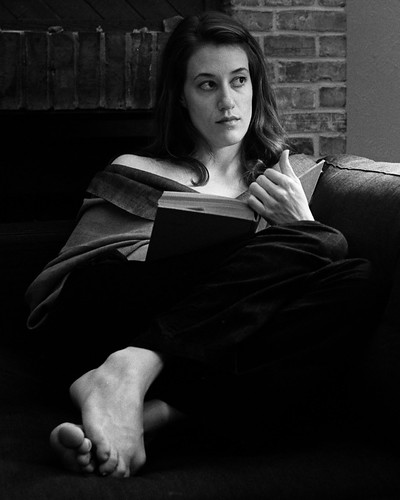 |
| That's better. |
This crop is basically what I was trying to do from the start, and I'm kicking myself a little that I didn't just do it in-camera. This is the process that Ansel Adams calls "visualization:" you don't just shoot and hope that something turns out, fixing it later by cropping. You imagine exactly what you want the final picture to look like, and then you manipulate the camera and film to get that image. That's what I'm striving for.
That being said, I got what I think is a very nice photo out of it, so it's not all bad. I'm just going to chalk this one up to experience and try again next week.
Bonus!
The day after I took the photo above, I took this one on 35mm. I don't have an instructive story to tell about this photo, but I like it. So I'm sharing it.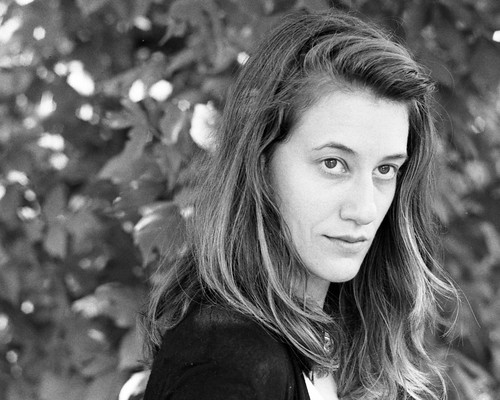
Thanks for stopping by. Drop me a comment if you like. I should have a new post next week, hopefully.
Monday, July 9, 2012
Week 3 - Flash
Meh.
The point of this blog is to shoot something every week and talk about it, in an effort to focus on and get better at my photography. Unfortunately, that means that not every week is going to be amazing. I almost didn't want to write something this week because I don't think the photos I did are very good, but I'm gonna power through.I decided that it was time to get over my hatred of flash photography. I actually already owned a flash that would work with my camera if I got an eight-dollar coupler, so I ordered the part and decided to spend the week experimenting.
First of all, let's look at this thing. I tell people that the flash for my camera is comically gigantic and I don't think anyone fully believes me. Here it is, next to a gin bottle for scale (and also because I was drinking gin). It's probably 150% as tall as the camera. It is a hilarious monstrosity and I almost am ashamed to take it in public. And to cap it all off, it has not one but two flash heads on it.
To be fair, that second flash head is pretty cool. It's fairly weak and is just there to soften shadows on peoples' faces. But the whole package just screams LOOK AT ME I'M A FLASH in a glorious, angular, 1980s way. This camera and flash set are from the era of the boombox; small wasn't really "in."
So I mounted that thing up and took some pictures of Rachel. Here's the first shot I took:
As you can see, the exposure is fine but it's kind of boring. I angled the flash head and bounced the light off the ceiling to keep it from being too harsh. Unfortunately, this is about as good as it was going to get.
We went out to eat and sat on the patio. There was obviously no ceiling from which to bounce anything, so the shots I took there were with the flash head dead-on. Sometimes it's almost passable:
 |
| A little harsh, but it'll do. |
And other times it's not.
 |
| People do not actually glow. |
We came back home and I bored her to death by making her sit for something like 20 shots in which I angled the flash head differently every time and took careful notes.
So what did I learn? I still hate flash photography. But I could stand to practice it more and hate it less. I can see that it could be useful in a studio setup, where the flash isn't on the camera itself but on a second tripod and at a different angle. That requires either a network of sync cables or very expensive modern wireless flash heads, neither of which I'm in the mood to acquire right now.
I may play with making a bounce card or a diffuser for the flash head, but I'm beginning to wonder if this is even worth my time. I'm not an event or wedding photographer, and I don't know if flash is something I need to learn. Part of me thinks that it's a waste of my time, but I suppose that if I become passable at using a flash and then intentionally never use it, I won't be worse for it.
Who knows, maybe it'll come in handy. I'm going to try to line up some natural-light portraiture this week, though.
Monday, July 2, 2012
Week 2 - Davida
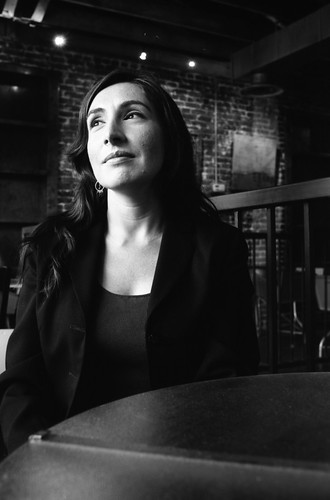 Take Pictures of People
Take Pictures of People
After my last blog post, Steve Metze (former instructor of mine, documentary filmmaker, and independent game publisher) suggested that I take pictures of people. I actually consider taking pictures of people to be my biggest strength in photography, but that's not to say I think I'm amazing at it. I just think that all of my best pictures are of people. This is one of the reasons I like to go and take boring pictures of trash cans sometimes--I'm trying to branch out.But there's plenty of learning for me to do in the world of portraiture. That's what this week is about.
The model this week is Davida Dwyer, a friend of mine from college. She is an attorney working in a state office, and I asked her if she needed any professional-looking lawyery photos. She's not in private practice, so she didn't really, but she humored me and we pretended she did.
I did two sets of photos with two cameras.
I used a medium format camera (my Yashica Mat 124) to take some color photos. I tend to focus almost entirely on black and white, so I felt that I should try to get some color experience. The difference in visualization and composition can be pretty strong between color and black and white, so I wasn't really sure how this would go.
Second, I took my trusty Nikon F3HP 35mm camera and shot some black and white. I did this mostly because I am more comfortable working black and white and I wanted to cover my bases.
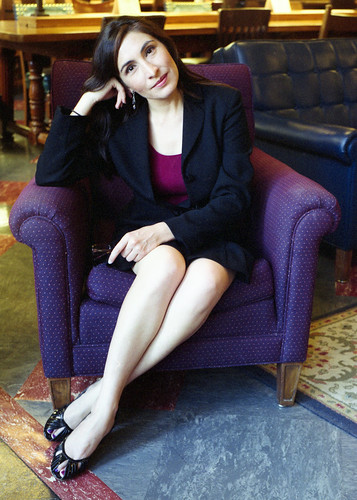 |
| Cropping after the fact leads to things like the edge of a couch poking in at the corner. |
Color
We shot the color photos inside the architecture library reading room in Battle Hall on the UT campus.I do not like flash photography, primarily because I am very bad at flash photography. I think I'm going to try to tackle that in a future edition of the blog. But for now, I needed to work with natural light, so I sat Davida by a window. This not only gave me ample light for photos but also ensured that the colors would come out correctly (if you shoot most color film under fluorescent light, everything looks nasty and green).
Unlike the rectangular 35mm format, the Yashica (along with several other medium format cameras) shoots in a 6 cm x 6 cm square format. I'm not so great at using the entire frame effectively. I ended up doing a lot of cropping after the fact. In a sense, this is good--I was able to get decent 8x10 crops out of these. But it was bad as well--I threw away a lot of the information on each negative to get to something I liked.
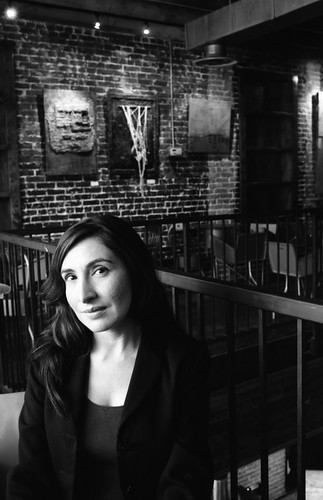 Black and White
Black and White
After we finished the color roll, we went across the street to Caffe Medici (which used to be called Metro, if you're of the same UT vintage as me). The upstairs loft there has one of my favorite big windows in town.I really love window light for black and white, but not because I need to worry about what color the light is. I love it because I am drawn to very directional, dramatic light. It creates nice contrast between the light and the dark in a frame and gives you great shadows.
I really do feel much more comfortable with black and white, and I think these photos are stronger than the color ones. I don't think they satisfy the goal of "professional portrait" but they suggest more of a story than the color ones. I guess it's hard to shake off all that film school.
Wrap Up
I'm much more happy with the black and white photos than I am with the color. While I feel like the color photos are technically good, they don't really appeal to me in the same way that the monochromes do. Part of that is my preference for black and white and part of it is my inexperience shooting color. Color portraiture often seems to be about using the color as a key element, almost as another personality in the shot. I know of people who do it beautifully, but I think that I have a lot of work to do if I want to work with it more often.All in all, not a bad week. Thanks to Davida Dwyer for letting me take the pictures, and thanks to Dano Johnson for reading the Onion out loud to us while we took the pictures. Dano, you're coming on all my photo shoots now.
Subscribe to:
Posts (Atom)

